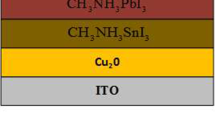Abstract
Since the neural network was introduced, significant progress has been made on data handling and learning algorithms. Currently, the most popular learning algorithm in neural network training is feed forward error back-propagation (FFEBP) algorithm. Aside from the success of the FFEBP algorithm, a polynomial neural networks (PNN) learning has been proposed as a new learning method. The PNN learning is a self-organizing process designed to determine an appropriate set of Ivakhnenko polynomials that allow the activation of many neurons to achieve a desired state of activation that mimics a given set of sampled patterns. In this paper, the PNN models have been developed using the sequential processes of high efficiency silicon solar cells experimental data. The output characteristics considered are reflectance, sheet resistance, diffusion depth, and cell efficiency. The influence of each parameters affected to efficiency is investigated through the main effect and interaction analysis. Sequential PNN process models are constructed to characterize the entire 3-step process. To characterize sequential processes using PNN, experiments were processed under varying conditions using central composite design (CCD) with three center points. It was shown that the output of the PNN model follows the real experimental measurement data very well.
Access this chapter
Tax calculation will be finalised at checkout
Purchases are for personal use only
Preview
Unable to display preview. Download preview PDF.
Similar content being viewed by others
References
Himmel, C., May, G.: Advantages of Plasma Etch Modeling Using Neural Networks Over Statistical Techniques. IEEE Trans. Semi. Manufac. 6, 103–111 (1993)
Mocella, M., Bondur, J., Turner, T.: Etch Process Characterization Using Neural Network Methodology: A Case Study. In: SPIE Proceedings on Module Metrology, Control and Clustering, vol. 1594, pp. 232–242 (1991)
Kim, B., Han, S., Kim, T., Kim, B., Shim, I.: Modeling Refraction Characteristics of Silicon Nitride Film Deposited in a SiH4-NH3-N2 Plasma Using Neural Network. IEEE Transactions on Plasma Science 31(3), 317–323 (2003)
Han, S., Bidstrup, S., Kohl, P., May, G.: Modeling the Properties of PECVD Silicon Dioxide Films Using Optimized Back-Propagation Neural Networks. IEEE Trans. Comp. Pack. and Manufac. Part A 17(2), 174–182 (1994)
Ivakhnenko, A.: The Group Method of Data Handling - A Rival to Stochastic Approximation. Soviet Automat. Contr. 13(3) (1968)
Madala, H., Ivakhnenko, A.: Inductive Learning Algorithms for Complex Systems Modeling, pp. 1–42. CRC Press, Boca Raton (1944)
Author information
Authors and Affiliations
Corresponding author
Editor information
Editors and Affiliations
Rights and permissions
Copyright information
© 2012 Springer-Verlag GmbH Berlin Heidelberg
About this chapter
Cite this chapter
Han, SS., Kim, I., You, C., Joung, J. (2012). Polynomial Neural Network Modeling for Sequential Processes of Silicon Solar Cell Fabrication. In: Sambath, S., Zhu, E. (eds) Frontiers in Computer Education. Advances in Intelligent and Soft Computing, vol 133. Springer, Berlin, Heidelberg. https://doi.org/10.1007/978-3-642-27552-4_87
Download citation
DOI: https://doi.org/10.1007/978-3-642-27552-4_87
Publisher Name: Springer, Berlin, Heidelberg
Print ISBN: 978-3-642-27551-7
Online ISBN: 978-3-642-27552-4
eBook Packages: EngineeringEngineering (R0)




